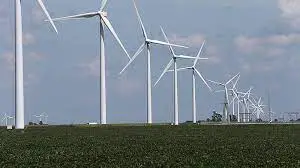On July 7, Amazon and AES Clean Energy unveiled the Delta wind farm project in Tunica, Mississippi. This project is significant as it is the first utility-scale wind farm in the state and aligns with Amazon’s goal of running all its operations on renewable energy by 2025. The wind farm will be located in Tunica County and will consist of 41 wind turbines that harness the powerful winds from the Mississippi Delta. What sets this project apart is its dual-use approach, utilizing the agricultural area surrounding the turbines for cultivating rice, soybeans, corn, and wheat. Amazon plans for the wind farm to start operating in 2024.
Amazon has partnered with AES Clean Energy, the developer and owner-operator of the Delta wind farm. This collaboration is expected to generate substantial tax revenue for the county and school district, amounting to tens of millions of dollars. Moreover, the project has already started creating economic benefits by providing employment opportunities to local builders and suppliers. During peak construction, it is projected to create nearly 300 jobs and contribute to the local economy.
The Significance of the Delta Wind Farm Project in Tunica
Once fully operational, the wind farm is estimated to produce approximately 1,850 gigawatt-hours (GWh) of clean energy annually. This amount of energy will be sufficient to power over 174,600 homes in the United States. Amazon’s commitment to renewable energy extends beyond Mississippi, with 30 renewable energy projects across the Southeast region. These projects include solar and wind initiatives in states like Arkansas, Georgia, Florida, Kentucky, Louisiana, Mississippi, and North Carolina. In total, these projects will have a capacity exceeding 7,500 GWh, providing power to more than 713,000 US households each year.
Charley Daitch, Director of Energy and Water Strategy at Amazon Web Services (AWS), emphasizes the company’s dedication to local communities. Daitch states, “Amazon is on a path to powering our operations with 100% renewable energy by 2025. And we want to ensure that the local communities where our customers live and work are also benefiting from the solar and wind projects that we support. These energy projects not only contribute to clean energy grids but also create jobs, support local businesses and farmers, and bolster the rural tax base in the Southeast. They form a crucial part of Amazon’s commitment to becoming a more sustainable company.”
FAQs
1. What is the Delta wind farm project in Tunica, Mississippi?
The Delta wind farm project is a collaboration between Amazon and AES Clean Energy to establish the first utility-scale wind farm in Mississippi. The project aims to harness the powerful winds from the Mississippi Delta using 41 wind turbines and also supports agricultural activities in the surrounding area.
2. When will the Delta wind farm start operating?
The wind farm is scheduled to start operating in 2024.
3. How much clean energy will the Delta wind farm produce?
Once fully operational, the wind farm is expected to produce approximately 1,850 gigawatt-hours (GWh) of clean energy annually, which can power over 174,600 homes in the United States.
4. What is Amazon’s goal regarding renewable energy?
Amazon aims to run all its operations on renewable energy by 2025.
5. How many renewable energy projects does Amazon have in the Southeast region?
Amazon has a total of 30 renewable energy projects across the Southeast region, including solar and wind initiatives in states like Arkansas, Georgia, Florida, Kentucky, Louisiana, Mississippi, and North Carolina.
6. How will the Delta wind farm project benefit the local community?
The project will generate significant tax revenue for the county and school district, create job opportunities during construction, and contribute to the local economy. It also supports local businesses, farmers, and the rural tax base in the Southeast.
Closing Statements
The Delta wind farm project in Tunica, Mississippi, is an innovative endeavor that demonstrates Amazon’s commitment to renewable energy and sustainability. By harnessing wind power and utilizing the surrounding agricultural area, the project provides clean energy, economic benefits, and support to the local community. With plans for further renewable energy projects across the Southeast, Amazon is actively working towards its goal of running all operations on renewable energy by 2025 and benefiting local communities in the process.



